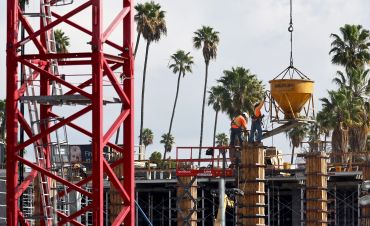Presented By: Christophe Garnier, CEO, Upflex
Can Hybrid Work Really Cut Your Company’s Carbon Footprint?
Upflex is proud to be a partner of Commercial Observer's IMPACT Series.
By Christophe Garnier, CEO, Upflex February 15, 2023 7:00 am
reprints
For many companies, 2023’s top priorities revolve around cutting costs and keeping business going, no matter what curveballs the economy throws in the new year. But the arrival of 2023 also means we are yet another year closer to the 2025 greenhouse gas emissions reduction targets set in the 2015 Paris Agreement. Some business leaders feel pressed to choose between focusing on the bottom line at the expense of their sustainability goals. Others are finding creative ways to do all of this seamlessly — with a future-forward rethink of their real estate strategy.
For occupiers looking to reduce their costs and their business’s environmental impact, the office is a very logical place to start: Real estate is the world’s single largest asset class — and the planet’s single largest contributor to the climate crisis. The built world is responsible for 40 percent of the world’s greenhouse gas emissions. Such a big slice of the pie translates into real potential to make progress.
Cutting commutes and energy consumption, cutting carbon
This year, my team at Upflex has been working with Schneider Electric, an Upflex client that, last year, was named “most sustainable corporation” out of 8,000 companies evaluated based on their science-backed net-zero targets, and their impact plan to save 800 million tons of CO2 for their customers by 2025. They chose Upflex to power their flexible workplace strategy — one that suits not only their real estate budget and their talent’s preferences, but also their “Earth first” values.
According to the company’s Chief Strategy and Sustainability Officer Gwenaelle Avice-Huet, Schneider’s push for the planet is part of a larger transformation, from being a hardware-focused engineering company to a technology-driven provider of services and software solutions to deliver efficiency and sustainability in office buildings, factories, data centers and otherwise.
Avice-Huet and the team at Schneider know that about 29 percent of the world’s carbon emissions come specifically from the built world’s operational aspect — lighting, heating and cooling. So, some of the aforementioned opportunity to reduce real estate’s carbon emissions lies in cutting back on the electricity, gas and water consumed at large offices.
Schneider is building tech to help other occupiers accomplish this — but they’re also leveraging proptech like Upflex to make their own office real estate strategy more energy efficient.
Even before the pandemic, Schneider saw that employees were already interested in workplace location flexibility, and following the pandemic, the option to work from home or in “third places,” such as coworking spaces, was in even greater demand. Using large, dedicated office spaces for fewer hours per week could alone theoretically reduce a company’s energy usage. But, moving the dial on carbon emissions isn’t quite this simple: To truly make a difference, occupiers also need a fail-safe way to track, anticipate, plan for and respond to office usage in order to truly reduce — much less measure — any energy usage reduction and its related effect on emissions.
Schneider is supplementing some of their own, dedicated hubs with existing, third-party, shared workspaces — which their employees choose at will from the 7,500-plus bookable workspaces in Upflex’s global space network. This has allowed Schneider to use less energy at their owned and leased properties while also lowering CO2 output by reduced commutes.
The world had the opportunity to observe the positive environmental effects of reduced commutes during the COVID-19 lockdowns in spring of 2020: global carbon emissions plummeted as downtown business districts went dark and commuters disappeared from the roads. Those lower numbers persisted into the following year: A 2021 Carbon Trust study showed remote work was linked to lower emissions in all six of the European countries the study considered. Schneider’s flexible workplace strategy gives employees the option to work closer to home, thereby slashing carbon emissions from cars and reducing oil dependence.

A future of clean real estate growth
Where about 29 percent of real estate’s carbon emissions come from energy usage, the remaining 11 percent or so comes from raw materials extraction and construction processes in new construction of buildings, office towers included. Thanks to innovations in the proptech space, sharing existing, high-quality workspace is increasingly easier.
With Upflex, occupiers are leveraging technology to use only existing assets or, as Schneider Electric is doing, to seamlessly incorporate existing real estate assets into their office strategy in place of less efficient owned or leased dedicated headquarters or hubs.
This approach to the office is an example of “clean real estate growth,” as CRETech CEO Michael Beckerman puts it: A company can continue to expand globally and, with great agility, open flexible new hubs and spokes in new markets around the world with Upflex’s network and workspace management solutions. But they aren’t racking up a utility spend on dedicated office. Instead, they’re chipping in with other companies who utilize shared workspace — and they’re not generating waste and carbon through their own new construction.
To give our sustainability-focused clients an even greater ability to track and clock their environmental goals, we’re currently working on a way to filter workspaces in our network based on eco-friendly measures like LEED certification and recycling programs. We’ve also formed a partnership with nonprofit Trees for the Future, so companies are able to offset yet more carbon by way of planting a tree for every desk booked. As of this year, our clients’ bookings have resulted in tens of thousands of new trees planted. For a 3,000-employee company using Upflex, each employee booking a desk five times per month means planting 180,000 trees annually — or removing an estimated 28,770 tons of CO2 from the atmosphere each year.
We make it secure and simple to find, book, pay for, manage and track use of all these spaces together in one convenient, centralized platform with one monthly invoice. The better we can do at utilization of existing space, the less energy office occupiers will consume, and the less necessary that construction of office buildings will become.
As Beckerman said in a conversation we had earlier this year, “These opportunities to grow and scale without increasing our environmental impact are just the kind of change that could help companies contribute to cleaner cities.”
For more articles on the future of workplace innovation click here.
Upflex is proud to be a partner of Commercial Observer’s IMPACT Series. We’re committed to kickstarting pressing conversations about how leaders within the prop tech industry can implement sustainable business practices and amplify the stories of people leading the charge for social change.


